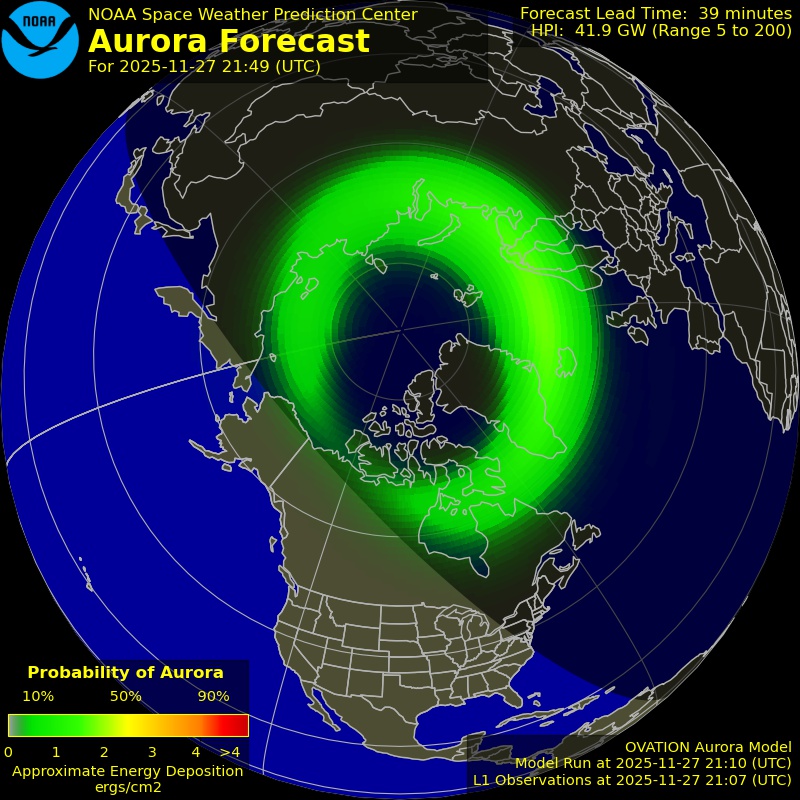Northern Lights Forecast for Regina
Substorm
Substorm Phase: Quiet; Aurora Activity Score: 15/100
Ideal Conditions for Northern Lights in Regina:
Power: +38 Gw | Bz: -2 | Wind Speed: 400+ | Density: 4+ | Kp: 4+
If the data above meets or exceeds the power meets then the aurora borealis should be visible within Regina.
Don’t Miss the Magic!
Stay ahead of the Northern Lights with real-time alerts. Subscribe now to receive a text or call whenever the aurora is active—so you never miss a moment of the show.
Welcome to our guide to experiencing the mesmerizing Northern Lights in Regina, Saskatchewan. Discover the optimal times, best locations, and essential tips to witness this awe-inspiring celestial display in the heart of the Canadian prairies.
Introduction – How to use this data:
Embark on a captivating journey to witness the enchanting Northern Lights in Regina through our advanced tool. Seamlessly forecasting aurora appearances, we transform live satellite data into a streamlined dashboard, removing any unnecessary clutter. While decoding this data may seem intricate, our comprehensive guide simplifies the process.
Enhance your Aurora-chasing adventure with our extended forecast feature. Plan your expedition in advance, building anticipation for the awe-inspiring Northern Lights spectacle that can grace the skies of Regina. Moreover, our real-time minute-to-minute forecast promise an immersive and personalized encounter you'll cherish.
Where to see the northern lights in Regina?
The enchanting dance of the Northern Lights in Regina can be best witnessed away from the city's bright lights. Seek out locations with unobstructed views of the northern horizon.
Here are some of our favorite places:
- Wascana Centre: This expansive urban park offers open skies, making it a convenient location to catch the auroras while staying within the city limits.
- Buffalo Pound Provincial Park: Just a short drive from Regina, this park offers darker skies, reducing light pollution and increasing your chances of a stunning aurora display.
- Katepwa Point Provincial Park: Head to this lakeside park for unobstructed views of the night sky, providing an ideal setting to experience the magic of the Northern Lights.
- Lumsden Beach: A popular spot for stargazing and aurora watching, Lumsden Beach provides a tranquil atmosphere away from the city lights.
- Rural Areas: Venture outside Regina to rural areas with minimal light pollution for a more immersive experience of the Northern Lights.
When can you see northern lights in Saskatoon?
Usually after dark around 11:00 PM to 3 AM the next morning. On very strong nights the northern lights have been able to be seen much earlier.
When is the best time of year to see the aurora borealis in Regina?
The enchanting Aurora Borealis can grace the skies of Regina throughout the year, but the best time to witness this captivating phenomenon is during the late fall, winter, and early spring months. These seasons provide longer periods of darkness, creating optimal conditions for the mesmerizing dance of the Northern Lights to unfold. While the auroras can make an appearance at any time, the extended darkness of these seasons increases your chances of experiencing the celestial spectacle in its full glory. Whether you're gazing up in wonder during the colder months or embracing the magic of the Northern Lights year-round, Regina offers a breathtaking experience under the starlit skies.
Can you see the northern lights in Regina tonight?
The possibility of witnessing the Northern Lights in Regina tonight hinges on a variety of factors, including solar activity and prevailing geomagnetic conditions. Stay tuned to real-time aurora forecasts on our website and app for the most up-to-date information. If the specific criteria align, there's a promising chance of experiencing the awe-inspiring Northern Lights illuminating the Regina night sky.
How long do the Northern Lights usually last?
The duration of the Northern Lights, scientifically known as the aurora borealis, can vary. On average, a single display of the Northern Lights may last anywhere from a few minutes to several hours. However, during periods of heightened solar activity and favorable conditions, the auroras can persist for several hours, creating a captivating and enchanting spectacle in the night sky. The exact duration depends on factors such as the intensity of the solar storm, atmospheric conditions, and the strength of the aurora display. Keep in mind that while some auroras are brief, others can offer an extended and breathtaking show, providing a memorable experience for observers.
Aurora Oval
Northern Hemisphere

